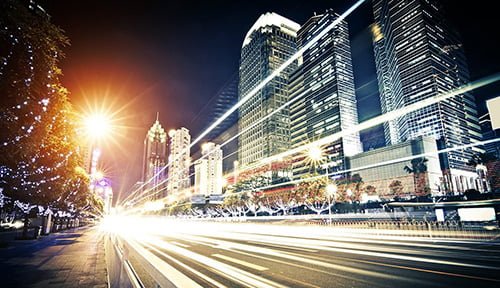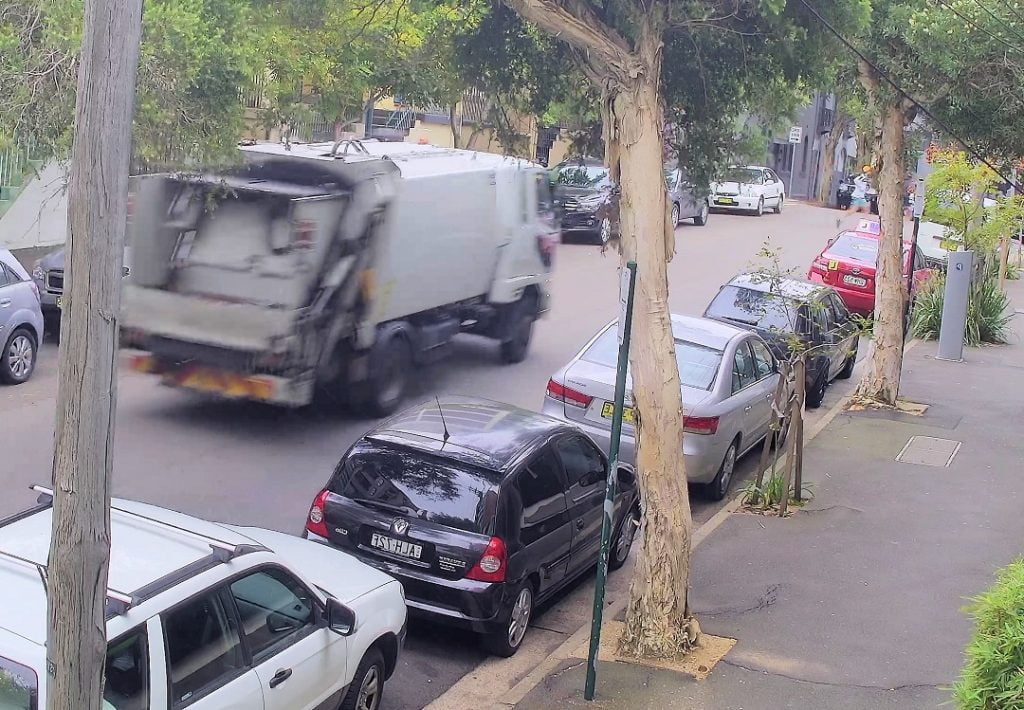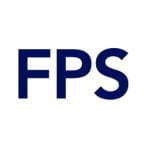Contents
Amplification noise versus blur – which is more acceptable to integrators when commissioning and more importantly, to end users when they are on the hunt for face recognition and license plates in low light?
FINDING a balance between motion blur and amplification noise is not easy but it’s worth the effort. Resistance to motion blur is primarily a factor of shutter speed. Some cameras manage to do better at the lowest default shutter speed settings of 1/25th or 1/30th of a second commonly seen in IP CCTV cameras. This suggests that in low light, digital rebuilding of high-resolution images stressed by elevated ISO may or may not increase frame-by-frame processing latency, depending on the design of the overall camera engine.
This results in loss of raw data in the form of light reflected from fast moving objects passing through the scene – in short, the camera system can’t keep up with changes taking place in its angle of view. The higher the resolution of the sensor, the more important processing efficiency becomes.
What all this means is that camera system processing capability is a vital aspect of IP camera performance that must be considered during the selection process. Making selection harder is the fact different camera models from the same manufacturer can be of significantly different capability with the same settings applied.
In reasonable light it’s possible to reduce motion blur by setting shutter speed higher than typical defaults of 1/25th of a second. You can select 1/60th, 1/120th, 1/250th or 1/500th without too much impact on overall scene quality if there’s sufficient light reflecting from the scene. But there is a trade-off. You’ll definitely get somewhat more moving detail with a 1/500th shutter speed for motion blur, but as light levels fall, you’ll also get more noise as the camera processor brightens the image by including more white digital stuff.

Unlike motion blur in photography, the difference in terms of the image’s appearance is not as large as you’d expect. Using 1/500th in a bid to get plates at night doesn’t work that well – you won’t get plates, but you will get a percentage more detail closer in. Moving plates in low light are tough. A faster shutter does help with moving faces. Faster shutter speeds work best where there is some light say – 7-10 lux minimum – and you are looking for faces to about 12m with standard varifocal lenses. Past this distance, amplification noise robs the image stream of detail when you zoom digitally.
Monochrome Use to Enhance
Something to seriously consider is use of monochrome for face recognition in low light. Don’t be shy about using it. If the end user grumbles, show them comparisons – they will almost always be indisputable. As we saw at SecTech Roadshow Camera Shootout last month, muddy, noisy colour video streams are overrated. And there’s a point with colour where you are likely to get almost no detail at all.
According to Vlado Damjanovski of CCTV Labs, the choice when balancing amplification noise and blur depends on what the user is trying to achieve.

“I would argue that this choice comes down to what the intention of the camera system is,” Damjanovski says.
“Amplified noise is a result of smaller pixels, lower light and higher temperature during camera operation.
“Blur is a result of the electronic exposure of the camera, which could be longer than the speed of movement of the object in front of the camera. If the camera needs to capture moving vehicles and read number plates, motion blur would be more critical to reduce then the noise. Numbers and letters on a number plate are regular patterns, and even if I have higher noise, I will be able to read the numbers as long as the electronic exposure (shutter) is fast enough to capture the plates with minimal blur.
“If I were to pick one over the other, from an identification perspective, I would choose noise, albeit from a situational awareness perspective you may argue that a lack of noise would be more desirable.
If I were to pick one over the other, from an identification perspective, I would choose noise, albeit from a situational awareness perspective you may argue that a lack of noise would be more desirable.
Consultant – Scott Myles
“On the other hand, if I have face identification system, and people are captured walking and looking straight to the camera, the blur from motion will be smaller (as they would move towards the camera) so having smaller noise would be preferred – just for the record, the ViDiLabs calc app has an easy motion blur calculation – the first in the industry!”
Pixel Size Counts
According to Damjanovski, getting the balance right depends on pixel sizes.
“If the pixel sizes are larger, e.g. ½-inch HD sensor, rather than a 1/3-inch 4K sensor, that would be a better choice for lower light,” he argues. “I think 10 lux should not be a problem if the pixels are larger.
In some of my seminars, we do calculations of the volume of photons falling on a pixel for the duration of 1/25s and we compare them to the noise electrons that exist in the sensor at the given temperature, and we also talk about the quantum efficiency of the sensors.
“To minimise the blur, you need to calculate the average speed of motion at the object of pick-up and based on that we can calculate the minimum allowed exposure setting, without reducing the frame rate (pictures per second). Taking this into account, you can decide if you require additional light, and how much.
“Personally, I am always against the use of IR, as when IR is at eye level for the purpose of identification, I consider it an OH&S issue. An optical camera with good sensor should give you sufficient image clarity without motion blur in most applications.”

For consultant, Scott Myles, amplification noise and vs blur are both annoying in an image stream and depending on the application the answer is subjective.
“If I were to pick one over the other, from an identification perspective, I would choose noise, albeit from a situational awareness perspective you may argue that a lack of noise would be more desirable,” Myles explains. “Our methodology is to fully understand the application and the desired outcome and to provide the most suitable recommendation.
Effect of Motion Blur
“The effect of motion blur is something we experience quite regularly and as such, the effect of motion blur within sub 10 lux environments is taken into consideration during the design phase. Some of the techniques that we have employed include additional lighting – white light or infrared – depending on the application. In addition, where possible we have also employed physical attributes that are designed to reduce the velocity and direction of the target in an attempt to mitigate against blur.
“Apart from backlight issues, we find motion blur one of the most challenging issues that we face when designing CCTV solutions and for this reason it becomes the catalysts for most of our on-site suitability trials, as each site presents its own idiosyncrasies and challenges.”
Doug Grant of CCTV Consultants says amplification noise and blur are an inherent problem in low light situations.
“These characteristics are symptomatic of long exposure times vs short exposure times,” Grant says. “Noise is generated by image sensor transistors as they buffer signals in low light.

“In my opinion, improvements in algorithms and sensor technologies will go a long way to resolve these issues. For end users and installers in the real world, choose specialised low light 1080p cameras, tweak shutter speeds and frame rates to suit the individual camera locations and take the time to explore different camera settings for improved performance.”
Meanwhile, Luke Percy-Dove of Matrix agrees both motion blur and amplification noise are a serious challenge for installers and end users.
“I am going to say amplification noise, but both are unacceptable operationally,” Percy-Dove says. “Amplification noise can be a more complex issue to resolve, while blur can often be attributed to the installer going with default settings instead of setting the camera up to handle the application.
“In sub-10 lux external applications where motion blur is going to be an issue camera placement is absolutely critical, as is the low-light and WDR performance of the camera. Where possible, have 2 capture points rather than just one,” Percy-Dove says.
“This may mean front and rear cameras for vehicles or multiple cameras on logical paths of travel for pedestrians. I almost never advocate IR because of the saturation you tend to see mid-scene which reduces detail. At the same time, movement-activated lighting is almost never practical.”
What is motion blur effect?

Motion blur is the apparent streaking of moving objects in a photograph or a sequence of frames, such as a film or animation. It results when the image being recorded changes during the recording of a single exposure, due to rapid movement or long exposure. Motion blur in photography is often used for effect.
Should motion blur be on or off?

The answer to this question depends a high number of variables such camera location, lighting, and environment. However, you can use this guide as instructions and test your own cameras in your environment.
Is motion blur good for FPS?

Motion blur can be one of the most important effects in the art of photography, but for CCTV systems it is quite the opposite. The goal is to climate all blur.
What does Lux mean?

The Lux (symbol: lx) is the unit of illuminance, or luminous flux per unit area, in the International System of Units (SI). It is equal to one lumen per square metre.
What is IR?

Infrared (IR), sometimes called infrared light, is electromagnetic radiation (EMR) with wavelengths longer than those of visible light. It is therefore invisible to the human eye.










